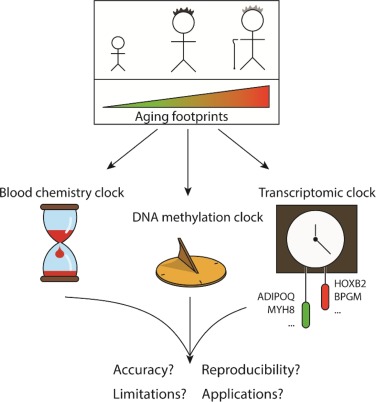Ageing Research Reviews ( IF 12.5 ) Pub Date : 2020-04-06 , DOI: 10.1016/j.arr.2020.101050 Fedor Galkin 1 , Polina Mamoshina 2 , Alex Aliper 3 , João Pedro de Magalhães 4 , Vadim N Gladyshev 5 , Alex Zhavoronkov 6

|
The aging process results in multiple traceable footprints, which can be quantified and used to estimate an organism's age. Examples of such aging biomarkers include epigenetic changes, telomere attrition, and alterations in gene expression and metabolite concentrations. More than a dozen aging clocks use molecular features to predict an organism's age, each of them utilizing different data types and training procedures. Here, we offer a detailed comparison of existing mouse and human aging clocks, discuss their technological limitations and the underlying machine learning algorithms. We also discuss promising future directions of research in biohorology — the science of measuring the passage of time in living systems. Overall, we expect deep learning, deep neural networks and generative approaches to be the next power tools in this timely and actively developing field.
中文翻译:

衰老的生物钟表和生物标志物:当前的最新水平,挑战和机遇。
衰老过程会产生多个可追踪的足迹,这些足迹可以量化并用于估算生物体的年龄。这种老化的生物标志物的例子包括表观遗传变化,端粒磨损以及基因表达和代谢产物浓度的变化。十几个衰老时钟使用分子特征来预测生物体的年龄,每个时钟都使用不同的数据类型和训练程序。在这里,我们提供了对现有鼠标和人类衰老时钟的详细比较,讨论了它们的技术局限性以及潜在的机器学习算法。我们还将讨论生物钟表研究的有前途的未来方向,即测量生命系统时间流逝的科学。总体而言,我们希望深度学习,











































 京公网安备 11010802027423号
京公网安备 11010802027423号